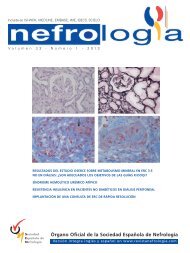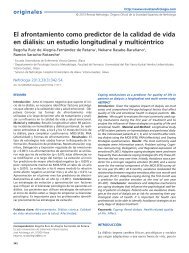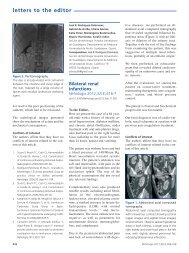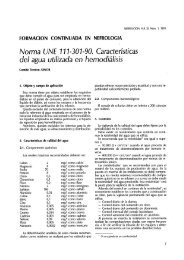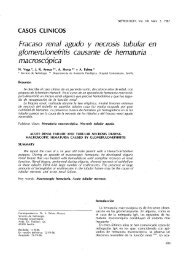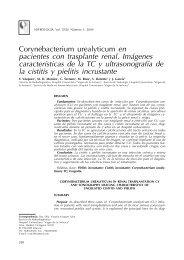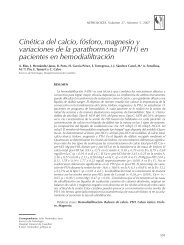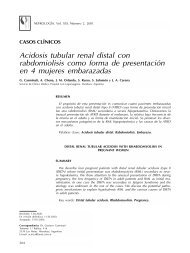PDF Número - NefrologÃa
PDF Número - NefrologÃa
PDF Número - NefrologÃa
You also want an ePaper? Increase the reach of your titles
YUMPU automatically turns print PDFs into web optimized ePapers that Google loves.
http://www.revistanefrologia.com<br />
© 2012 Revista Nefrología. Órgano Oficial de la Sociedad Española de Nefrología<br />
artículo especial<br />
La situación laboral del paciente con enfermedad<br />
renal crónica en función del tratamiento<br />
sustitutivo renal<br />
Juan C. Julián-Mauro 1 , Jesús Á. Molinuevo-Tobalina 2 , Juan C. Sánchez-González 3<br />
1<br />
Gerencia. Fundación Renal ALCER España. Madrid<br />
2<br />
Asesoría de Diálisis. Fundación Renal ALCER España. Madrid<br />
3<br />
Unidad de Diálisis. Fundación Jiménez Díaz. Madrid<br />
Nefrologia 2012;32(4):439-45<br />
doi:10.3265/Nefrologia.pre2012.Apr.11366<br />
RESUMEN<br />
Antecedentes: La enfermedad renal crónica (ERC) es una patología<br />
limitante, sin embargo están demostrados los beneficios<br />
que la actividad laboral produce en estos pacientes. La<br />
modalidad de tratamiento sustitutivo renal (TSR) puede influir<br />
sobre dicha actividad laboral. Objetivos: Analizar la situación<br />
laboral de las personas con ERC en función del TSR:<br />
hemodiálisis (HD), diálisis peritoneal manual (DPCA), diálisis<br />
peritoneal automática (DPA) o trasplante (Tx). Métodos:<br />
Análisis descriptivo de la situación laboral de 243 pacientes<br />
renales de ambos sexos entre 16 y 64 años, que llevan a cabo<br />
TSR con HD, DPCA, DPA o Tx en 8 hospitales españoles. Resultados:<br />
Sólo el 33,3% de los pacientes con insuficiencia renal<br />
en edad laboral están trabajando. Se observan diferencias<br />
estadísticamente significativas en el porcentaje de<br />
ocupados entre hombres (40,1%) y mujeres (22,9%), entre la<br />
edad media de los ocupados (43,5 años) y los no ocupados<br />
(49,6 años), y también en el tiempo medio de tratamiento<br />
de ocupados (4,8 años) y no ocupados (7,9 años). Por último,<br />
existen también diferencias en el porcentaje de ocupados en<br />
función del TSR consideradas, siendo el más elevado en los<br />
pacientes en DPA (47,8%), y el menor, el de los pacientes en<br />
HD (21,7%). Conclusiones: La ERC y los TSR son un importante<br />
factor de incapacidad laboral. Los pacientes en activo optan<br />
mayoritariamente por un tratamiento de DPA; casi la mitad<br />
de los pacientes en DPA están trabajando, mientras que<br />
en HD apenas trabaja uno de cada cinco pacientes en edad<br />
laboral.<br />
Palabras clave: Empleo. Tratamiento sustitutivo renal.<br />
Enfermedad renal crónica.<br />
Employment in the patient with chronic kidney disease<br />
related to renal replacement therapy<br />
ABSTRACT<br />
Background: Chronic kidney disease (CKD) is a limiting<br />
condition, but they are shown the benefits the work activity<br />
occurs in these patients. The modality of renal replacement<br />
therapy (RRT) can influence the activity of work.<br />
Objectives: Analyze the employment of people with CKD<br />
related to of RRT in which they are: hemodialysis (HD), peritoneal<br />
dialysis manual (CAPD), automated peritoneal<br />
dialysis (APD) or transplantation (Tx). Methods: Descriptive<br />
analysis of the employment about 243 kidney patients<br />
of both sexes between 16 and 64 years, conducting<br />
RRT with HD, CAPD, APD or Tx from 8 Spanish hospitals.<br />
Results: Only 33.3% of patients with RRT in the working<br />
age were employed. Statistically significant differences<br />
are observed in the percentage of employed men (40.1%)<br />
and females (22.9%), between the average age of the employed<br />
(43.5 years) and unoccupied (49.6 years), and in<br />
the mean time to treatment of employees (4.8 years) and<br />
unoccupied (7.9 years). Finally there are also differences<br />
in the percentage of employed persons in the various<br />
forms of TSR considered, being much higher in APD patients<br />
(47.8%) than in patients on HD (21.7%) having the<br />
lowest percent. Conclusions: Chronic Kidney Disease<br />
(CKD) and RRT are a major source of disability. Active patients<br />
opt for treatment largely APD, so that almost half<br />
of the patients in this modality are working, while in HD<br />
only one of every five patients is working.<br />
Keywords: Employment. Renal replacement therapy.<br />
Chronic kidney failure.<br />
Correspondencia: Juan C. Julián Mauro<br />
Gerencia.<br />
Fundación Renal ALCER España.<br />
Don Ramón de la Cruz. 28006 Madrid.<br />
jcjulian@alcer.org<br />
frae@alcer.org<br />
INTRODUCCIÓN<br />
La enfermedad renal crónica avanzada es una patología que<br />
limita de forma considerable las capacidades de la persona<br />
439



